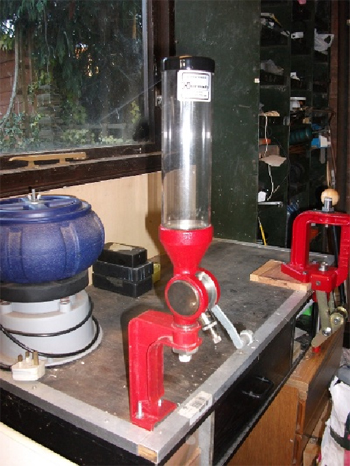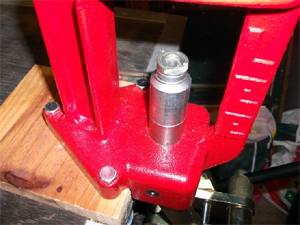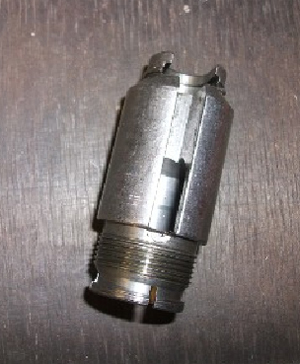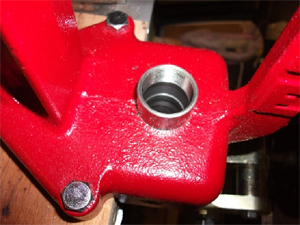|
When my trusty Lee Challenger press finally gave up the ghost after 10,000+ reloads (yes, sad but I keep records) I was faced with two dilemmas. 1- what to do with the broken Challenger & 2 - what to replace it with.
The Challenger had broken at the linkage after resizing un-lubed .303 cases but the frame was still OK. I hate throwing things away that might just still be useful so after a bit of thought I took a hacksaw to it and 20 minutes later I had a new stand for my Hornady powder measure. I had been using the as-supplied flat pressed steel mount for the Hornady until now, as the bench mount was £20 +. As you can see, the chopped-up Challenger was not only an ideal bench mount for the Hornady measure but it was even colour-matched! Elegant - not really. Free - yes.

The next question was what to replace it with. I wanted an RCBS RockChucker but the Lee Classic Cast is a whole lot cheaper & that's what I ordered, from Henry Krank. (£98 plus £4 delivery)
First impressions were mixed. The Lee cast press was not as heavy as I expected. I did think it was going to be a hefty great beast but actually it wasn't. I also expected it to be a lot more "powerful" than the wonky old Challenger press but I guess that defeats the laws of physics. The press itself hasn't got any power in it & all the reloading effort comes from my right arm.
Anyway, it was obviously a lot beefier than the old challenger and once I'd bolted it to the bench I had a good look at it. The first thing I looked at was the top half of the ram. This is clearly a separate part and I soon found that it was detachable. It unscrews, using the priming arm as a lever. This is when I found out why the press is lighter than expected. The ram is tubular. Not just drilled but hollow. Now, I did wonder whether this means the ram is weedier than it could be but then common sense kicked in. Lee offer a .50BMG kit for this press & I can't see them doing that if there was any inherent problem. Anyway, most of my loading would be 357 mag. Hardly a challenge to even the smallest press.
The ram, top section, & view of the open ram are shown below
 

Here you can clearly see that the ram is not solid and the walls are not perhaps as thick as you'd expect. However, the top section is a good fit and appears to be well-machined.
The other aspects of the press I was interested to try were the spent primer collection, & the on-press priming attachment. Spent primers on this press are supposed to drop down inside the ram & accumulate in a piece of plastic tube attached to the bottom of the ram. This works to a degree, but look at that picture of the ram extension above. If you haven't got the priming arm attached, pistol primers have a knack of finding their way out through that big slot in the side of it & dropping on the bench...
On the subject of the priming attachment, this was a new toy for me. I have previously used the Lee hand prime & never tried priming on-press. Verdict? Didn't like it. You can't really feel how hard you're seating the primers & on the pistol ones I noticed they weren't quite seated fully, even pushing the lever as far as I dared. For the amount of time saved (if any) it isn't worth it to me.
Either way, the proof of the pudding is in the eating. The press works well, & the only niggle for me is that the frame is not offset like the Challenger. Minor point, but it makes the case handling more fiddly. For 100 quid (give or take a few bob) I'd recommend it.
Mark Davey
|


































